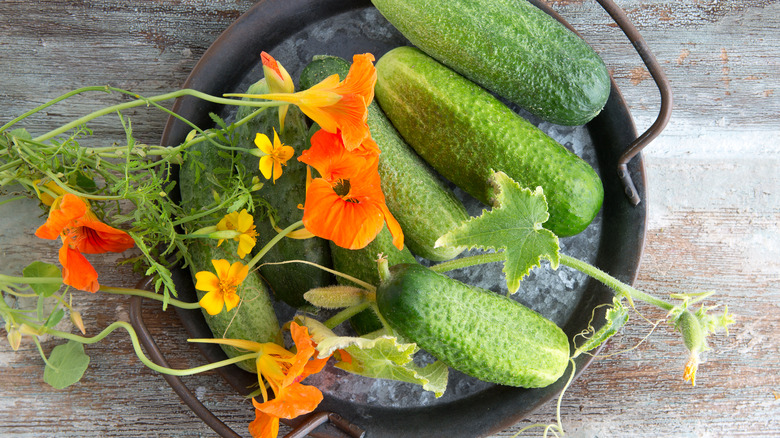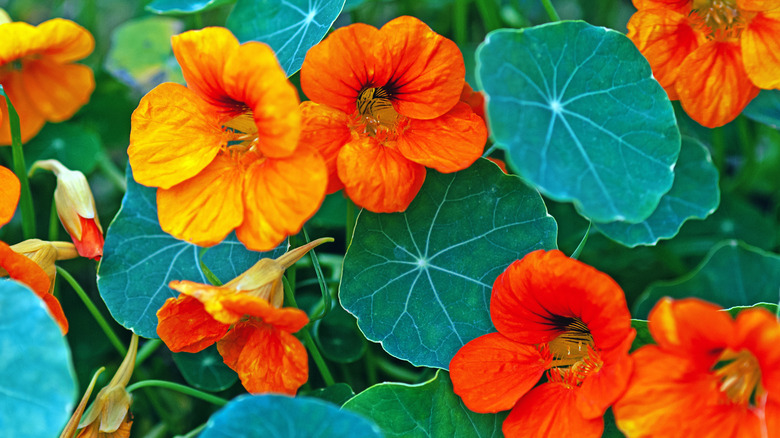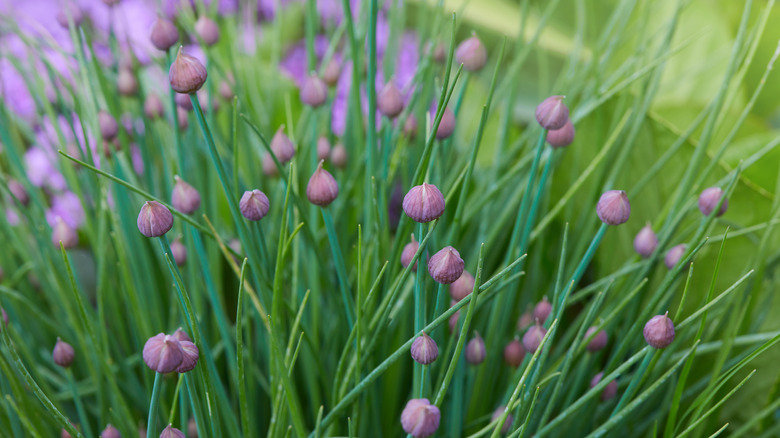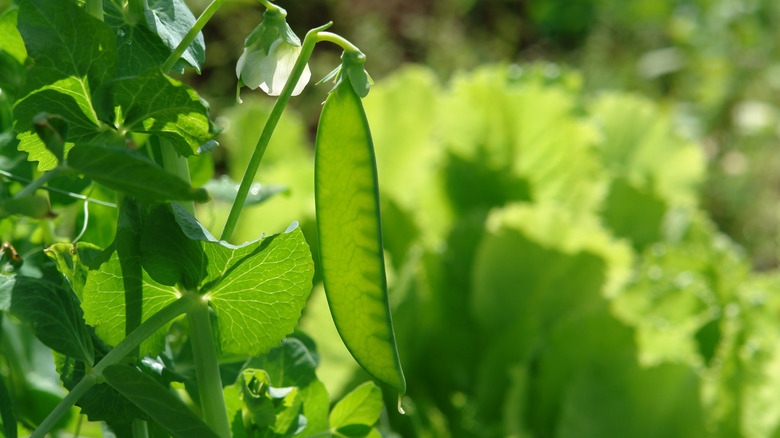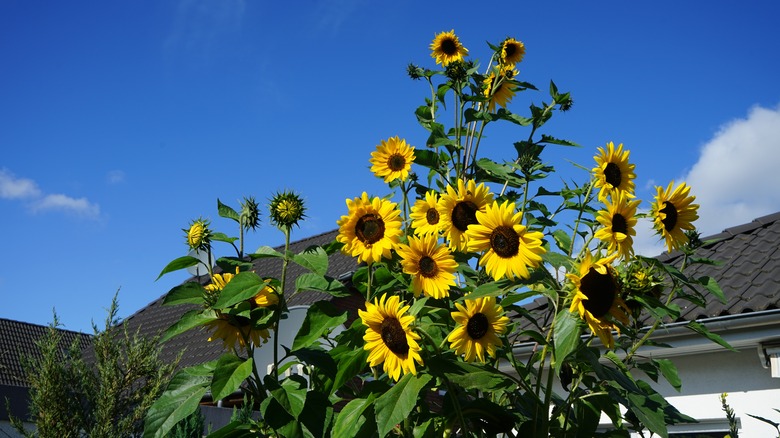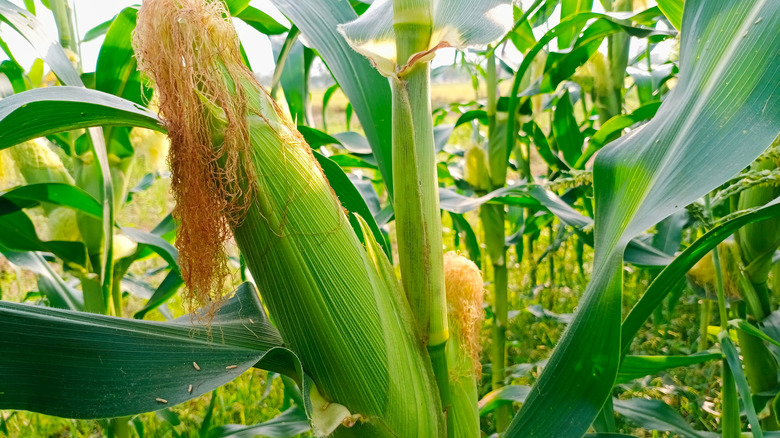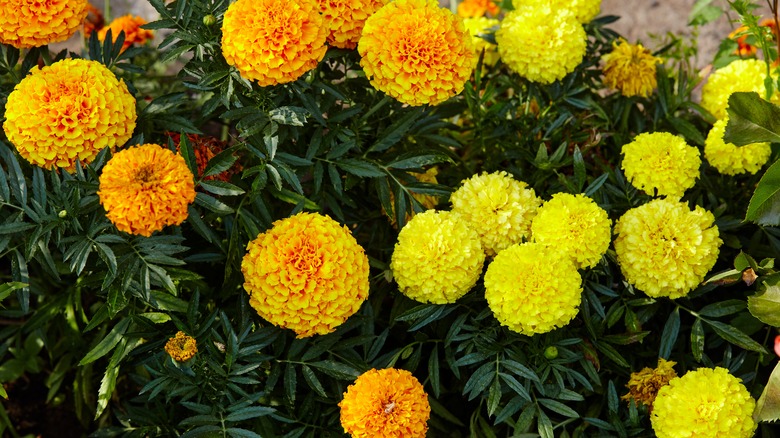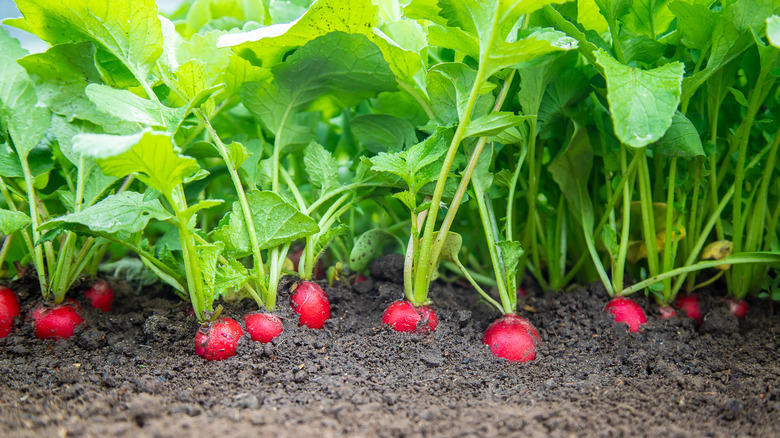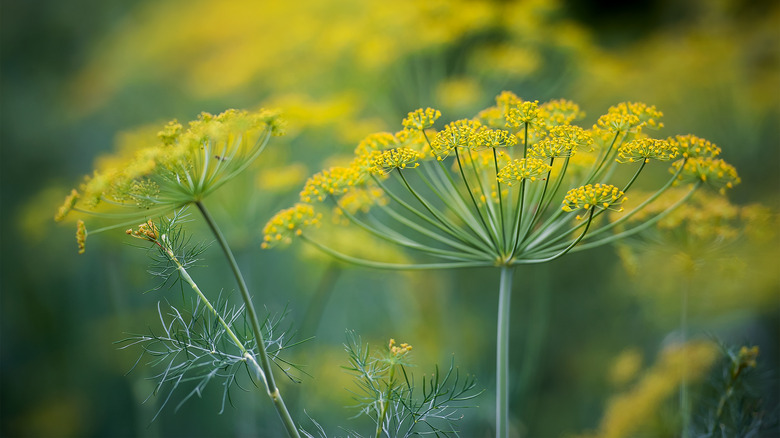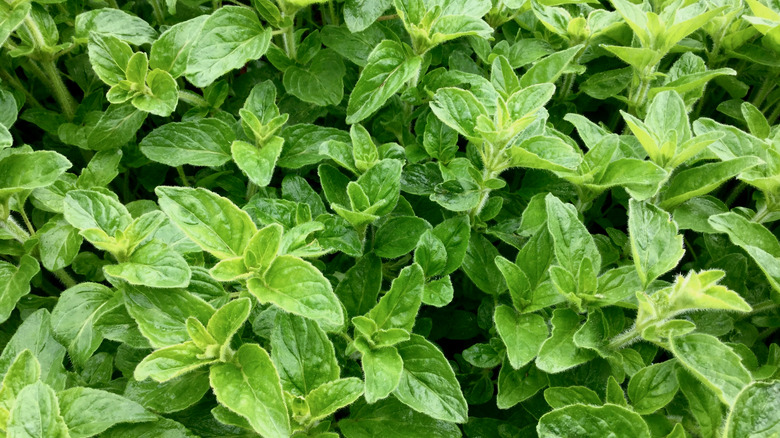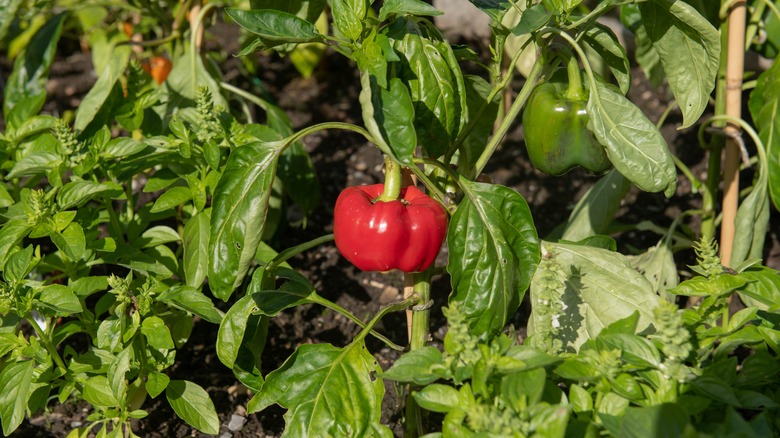10 Companion Plants You Should Grow Next To Cucumbers In Your Garden
Companion planting is a common technique that amateur and expert gardeners both use. Though it is not an exact science, it's usually agreed that planting certain species of flowers, herbs, vegetables, and fruit-bearing plants together will increase their production, speed up their growth, and make them grow healthier. This is because of each plant's natural ability to repel harmful insects, attract pollinators, ward off feeding animals, or enrich the soil beneath them. Cucumbers have several friends in the garden. Some fend off weeds, insects, and disease, while others add nitrogen to the soil or simply break it up if it's too dense.
As a general rule, you shouldn't plant cucumbers and aromatic herbs together, as noted by West Virginia University Extension. However, herbs such as dill and oregano are just a couple of exceptions to this rule. Both extremely fragrant herbaceous plants help to deter destructive insects that are known to harm cucumber plants similarly to nasturtium and French marigolds. If you're having trouble growing healthy cucumber plants, refer to our collection of ten companions with which your cucumbers will form beneficial relationships.
1. Nasturtium
Nasturtium (Tropaeolum spp.) is commonly found growing in herb and vegetable gardens. This easy-to-care-for annual blooms from the spring to fall for wonderful color throughout the growing season, says Missouri Botanical Garden. When grown nearby vegetable plants, like cucumbers, the nasturtium plant repels many harmful insect species away from the produce. They may also help to keep nasty weeds from invading your garden as they sprawl across the soil.
Bloom Season: Spring to fall
USDA Growing Zone: 2 to 11
Growing Conditions: Full sun
Soil Type: Well-draining
Size: 1 to 10 feet tall and 1 to 3 feet wide
2. Chives
Chives (Allium schoenoprasum) can have a positive impact on your home garden when you plant them near your cucumbers. In addition to their great taste when paired with the vegetable in several dishes, chives can actually help you drive away pests and pesky animals due to their strong onion or garlic scent, as noted by RHS.
Bloom Season: Summer
USDA Growing Zone: 4 to 8
Growing Conditions: Full sun to partial shade
Soil Type: Evenly moist and well-draining
Size: 4 to 20 inches tall and 4 inches wide
3. Peas
Peas (Pisum sativum) are among the best companion plants for cucumbers due to their roots' ability to nourish the soil by increasing its nitrogen content, as explained by North Carolina State Extension. More nitrogen in the soil allows cucumbers, and many plants nearby, to grow more quickly and produce healthy vegetables.
Bloom Season: Spring and fall
USDA Growing Zone: 2 to 11
Growing Conditions: Full sun to partial shade
Soil Type: Sandy and well-draining
Size: 12 to 18 inches tall and 6 to 12 inches wide
4. Sunflowers
Sunflowers (Helianthus annuus) are always a beautiful addition to any garden. However, these tall-growing flowers aren't just grown for their beauty. Sunflowers attract a range of beneficial wildlife to your garden, so all of your plants can grow healthy and strong. According to the California Native Plant Society, these large flowers are attractive to pollinators like bees, butterflies, and hummingbirds as well as other beneficial predatory insects.
Bloom Season: Summer to fall
USDA Growing Zone: 2 to 11
Growing Conditions: Full sun
Soil Type: Rich, loose, and well-draining
Size: 5 to 10 feet tall and 2 feet wide
5. Corn
Corn (Zea mays) may seem like a strange addition to a home garden. These tall, leafy plants aren't commonly grown in backyards in most regions. Yet, if you are serious about raising a productive summer and fall vegetable garden, planting corn is not a tough decision to make. As pointed out by North Carolina State Extension, corn grows straight, erect stems as it ages. These stems are used by cucumber plants as a natural trellis.
Bloom Season: Summer
USDA Growing Zone: 2 to 11
Growing Conditions: Full sun
Soil Type: Well-draining
Size: 5 to 8 feet tall
6. Marigolds
Marigold flowers (Tagetes patula) act similarly to nasturtium flowers in a vegetable garden. Throughout the spring, summer, and fall, they show off bright and fragrant flowers that many insects don't enjoy, as told by Ohio State University. Because of this, they ward off destructive beetles and thrips wanting to eat your cucumber plants.
Bloom Season: Spring to fall
USDA Growing Zone: 2 to 11
Growing Conditions: Full sun to partial shade
Soil Type: Moist and well-draining
Size: 6 to 12 inches tall and 8 to 18 inches wide
7. Radishes
Radishes (Raphanus sativus), which are root vegetables like carrots and onions, are an obvious choice for a vegetable garden. Not only do they taste great when roasted with garlic or mixed into a summer salad with thinly sliced cucumber, but they also grow very well nearby above-ground plants like cucumbers because of their growth habit. Missouri Botanical Garden suggests keeping these plants in direct sunlight for the best growth.
Bloom Season: Spring
USDA Growing Zone: 2 to 11
Growing Conditions: Full sun
Soil Type: Sandy or loamy
Size: 2 to 3 feet tall
8. Dill
Dill (Anethum graveolens) is a weedy culinary herb that has a fern-like growth habit. Its fine and branching leaves are fragrant and easily harvested in the summer. These leaves are typically dried or used fresh for pickling or seasoning a variety of dishes. As mentioned by the University of Wisconsin-Madison, dill plants grow well with other herbs and vegetables because their flowers and foliage attract aphid-eating hoverflies and black swallowtail butterflies.
Bloom Season: Summer
USDA Growing Zone: 2 to 11
Growing Conditions: Full sun
Soil Type: Rich and well-draining
Size: 18 inches to 4 feet tall
9. Oregano
As stated by Washington State University, oregano (Origanum vulgare), like dill, attracts a few different beneficial insects to the garden and wards off the ones that enjoy feasting on your hard work. This herb, which is filled with fragrant leaves used in the kitchen, is very easy to grow and a no-brainer when considering companion plants for your cucumbers.
Bloom Season: Summer
USDA Growing Zone: 3 to 9
Growing Conditions: Full to partial sun
Soil Type: Well-draining
Size: 2 feet tall and wide
10. Bell pepper
Bell pepper plants (Capsicum annuum, Grossum Group) are well-known for their multi-colored fruit. These not-so-spicy peppers can be yellow, green, orange, purple, or red. Cucumbers and bell peppers won't necessarily help each other, but they share the same growing conditions. If you have a small garden, plant the two together in a full sun location with evenly moist soil, and fertilize them in the spring, as recommended by North Carolina State Extension.
Bloom Season: Summer
USDA Growing Zone: 9 to 11
Growing Conditions: Full sun
Soil Type: Moist and well-draining
Size: 6 to 60 inches tall
